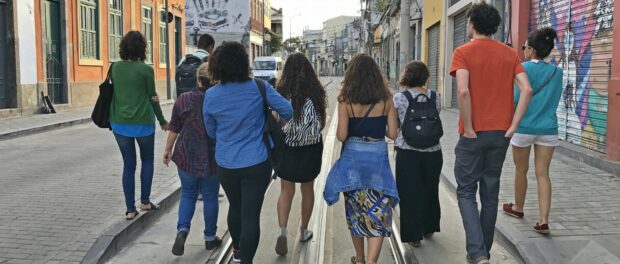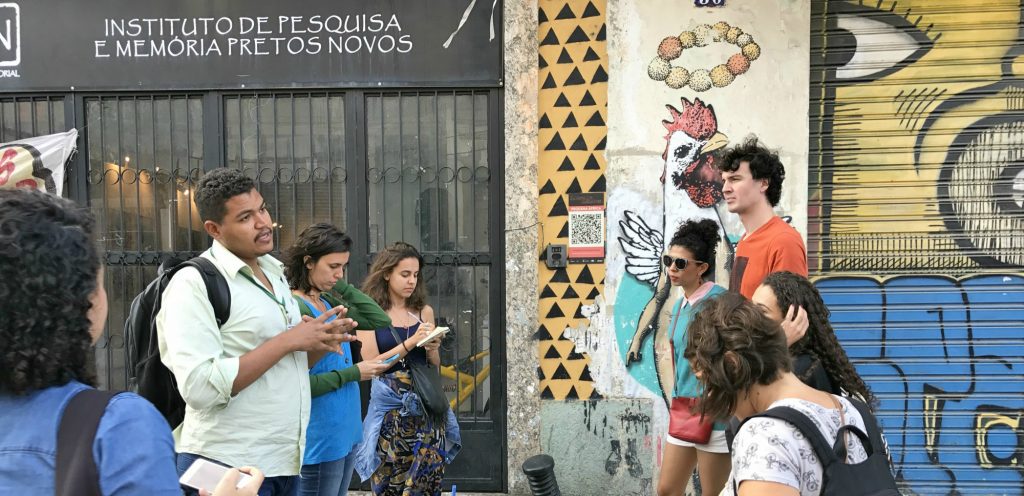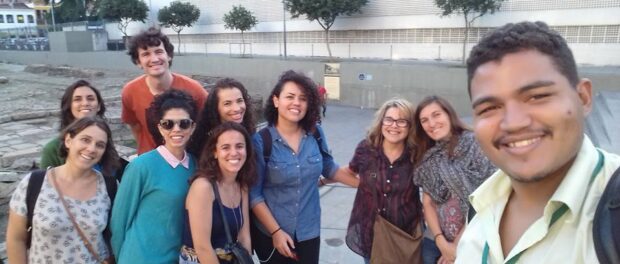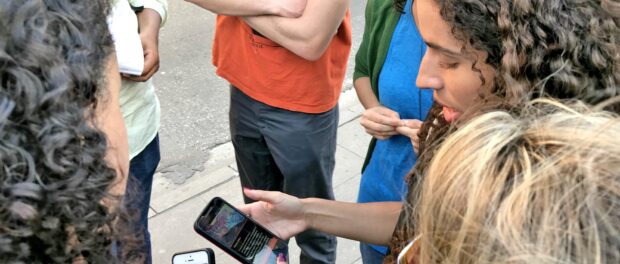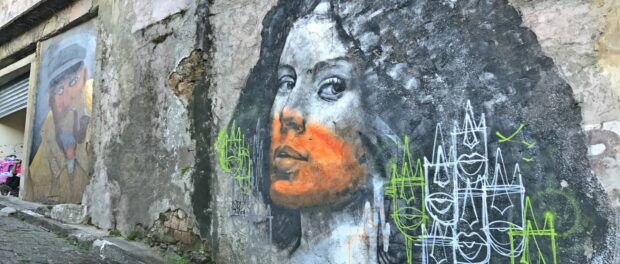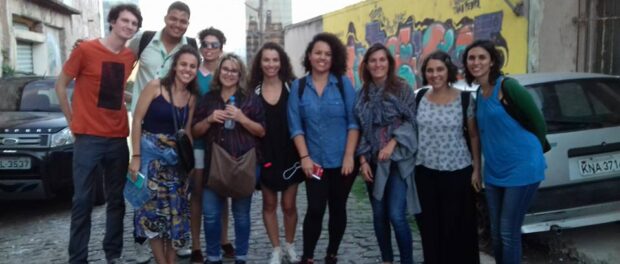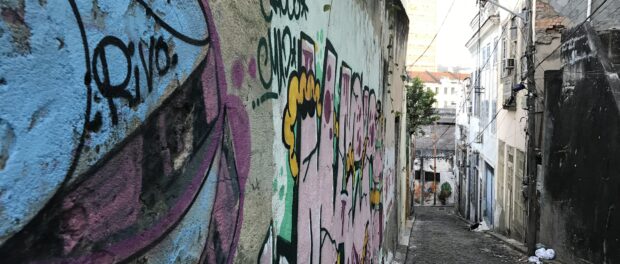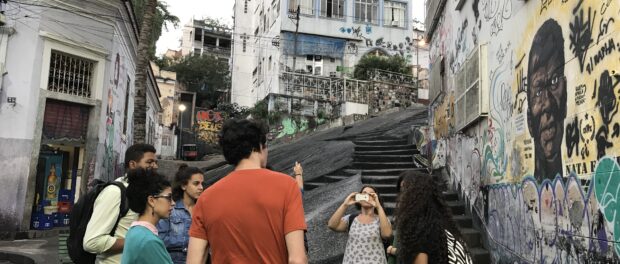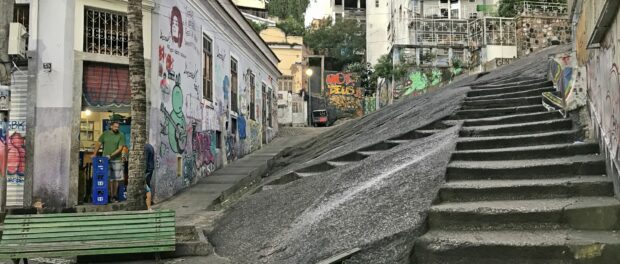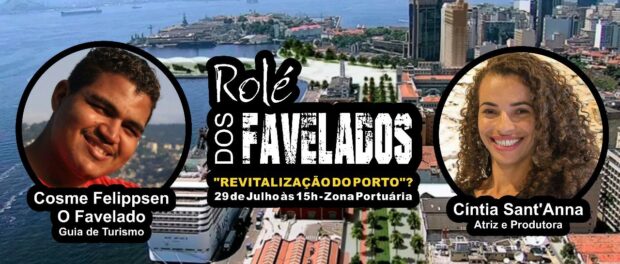
Recently, a new edition of the unique tour style, Rolé dos Favelados (Stroll of the Favelados), took place, this one questioning the Port Revitalization which happened before the 2016 Olympics. The idea behind the Rolé dos Favelados is to experience a critical look at Rio de Janeiro on tours led by local favela guides and activists. Tours have so far taken place in Morro da Providência (Rio’s first favela), Santa Marta and Vila Autódromo. All were led by different community activists dedicated to combating the stigmatization of Rio’s favelas.
Involved in all the tours is guide Cosme Felippsen, who in the case of the Port tour was accompanied by actress and producer Cintia Sant’Anna. Felippsen, with a degree in tourism, began acting as a tour guide at the age of eight, recognizing the need to change the negative perceptions that non-residents have of favelas. Cintia, also a native of Providência, is an inspirational young lady, having co-created, in 2015, the online platform Entre o Céu e a Favela (Between the Sky and the Favela) to unite, spread and value cultural products, art and social development in Morro da Providência and neighboring Morro do Pinto. She also co-funded the theater company Bando Teatro Favela (Favela Theater Band).
Both want to spread a more nuanced message about favelas as living sites of historic value as well as creative, culturally- and socially-rich places in constant transformation. They see the tours as an opportunity for residents to disprove the negative stereotypes that dominate media and policymakers’ narratives about favelas and their often poor, black residents. Most importantly, during this specific tour, they wanted to deconstruct the official narrative according to which the Port Zone was “abandoned” before its “revitalization” through the Marvelous Port project, which essentially transformed the area into a tourist attraction.
Indeed, this area is home to Morro da Providencia, Rio’s first favela, but also to many key historic sites of critical importance to Afro-Brazilian history, such as the New Blacks Institute (IPN), the Valongo Wharf, Valongo’s Hanging Garden and the famous Salt Stone, or Pedra do Sal. The tour started at Harmony Square and visited IPN, the Valongo Wharf, a street art gallery, the Salt Stone and ended at the renovated Praça Mauá, in front of the Rio Museum of Art (MAR). Tour participants were mostly Brazilian, some of them being architecture or urban planning students or professors and others journalists.
1. The New Blacks Institute (Instituto Pretos Novos, or IPN)
This museum situated in Rio’s Port Region hosts the largest slave cemetery in the Americas and one of the main sites preserving the city’s legacy as the largest slave port in world history.
2. The Valongo Wharf
The dock was the largest arrival point for enslaved Africans brought to Brazil–or anywhere. It has recently been recognized as a UNESCO World Heritage Site. According to UNESCO it is “the most important physical trace of the arrival of African slaves on the American continent. From a historic point of view, this is a testimony to one of the most brutal episodes in the history of humankind.”
During this stopover, Cintia showed and explained different existing mobile applications that allow visitors to deepen their understanding of Rio’s Port region and in particular the region known as Little Africa, such as Museum of Yesterday and Passados Presentes.
3. Street Art Gallery
This street art gallery is one of the entrances to Morro da Providência, the one used by Cosme during his tour of the favela. Beautiful graffitis made by local artists are displayed on the walls. Cosme chose this site to ask his usual yet important question to the audience: “What is a favela?”
4. Salt Stone, or Pedra do Sal
The Salt Stone, or Pedra do Sal, where salt and other goods were traded over hundreds of years when the Guanabara Bay’s waters reached it (prior to the land filling of the bay)–is home to a quilombo and was re-popularized in recent years due to its hosting weekly Monday and Friday night street samba parties and other events. The site is considered the “cradle of Brazilian samba” where several of the original samba songs were composed a century ago. It was actually three times in size and according to Cintia, sugar was also traded here in more important quantities than salt. Locals always held parties at Pedra do Sal but since the region’s revitalization, Cintia says there are now more tourists than locals. She used this stop as a moment to discuss the latest attempts to criminalize funk, remembering the criminalization of popular culture has happened many times in Brazilian history, including with samba itself. Cintia explained that in general authorities like to keep control over favela-related activities. Even a recent art festival Cintia organized in Providência was stopped by police, who were present throughout the event, dissuading residents from joining.

